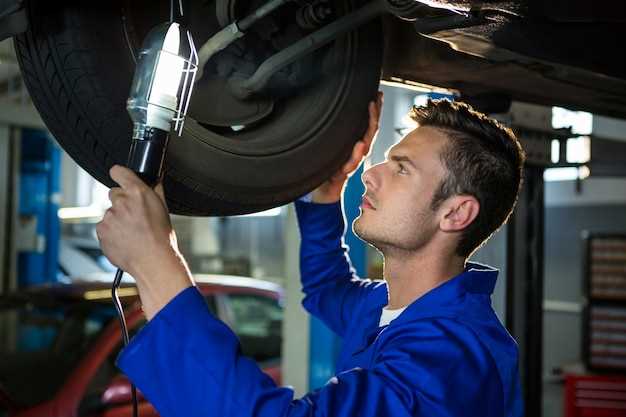
Maintaining proper alignment is crucial for the performance and longevity of your vehicle, especially after significant suspension work. A well-aligned vehicle ensures that all four wheels work harmoniously, promoting even tire wear and optimal handling characteristics. Ignoring alignment needs post-suspension can lead to accelerated deterioration of tires and other crucial components, resulting in costly repairs down the line.
After any adjustments or replacements in your suspension system, it’s essential to verify that the alignment is within the manufacturer’s specifications. This process can help you regain control over your vehicle’s steering response and overall driving experience. Furthermore, keeping an eye on the angles of your wheels will help maximize traction and fuel efficiency, allowing your Corrado to perform at its best.
Utilizing a professional alignment service is highly recommended after making changes to your suspension. However, understanding the factors influencing alignment will equip you with the knowledge needed to monitor your vehicle closely and ensure everything remains in top condition. With the right attention to detail, you can enjoy a smooth and stable drive, extending the life of your tires and enhancing your overall driving experience.
Understanding Wheel Alignment Basics for Corrado
Wheel alignment is a crucial aspect of vehicle maintenance, particularly for the Volkswagen Corrado, which benefits greatly from precise suspension tuning. Proper alignment ensures that all four wheels are positioned correctly relative to each other and the road, affecting handling, tire wear, and overall driving performance.
Key components of wheel alignment include:
- Camber: This refers to the angle of the wheels when viewed from the front of the vehicle. Positive camber means the top of the wheels is pointing outward, while negative camber means it is pointing inward. For the Corrado, maintaining a slight negative camber is often recommended for enhanced cornering stability.
- Toe: Toe alignment determines how much the wheels point inwards or outwards. A toe-in alignment means the front of the tires is closer together than the rear, while toe-out means the opposite. For optimal handling, especially after suspension work, the toe should be set according to the desired driving characteristics.
- Caster: This is the angle of the steering axis when viewed from the side of the vehicle. A positive caster angle helps with straight-line stability and steering returnability, which is particularly important for the sporty handling of the Corrado.
When performing suspension tuning on the Corrado, following these alignment basics is vital:
- Always assess the suspension components for wear and damage before adjusting wheel alignment.
- Use a trusted alignment machine for accurate measurements to avoid further issues.
- Consider the driving style and conditions; aggressive driving may require different alignment settings compared to daily driving.
- After any suspension modifications, it’s essential to re-check alignment as changes can alter the angles significantly.
In conclusion, understanding and applying wheel alignment basics is essential for the performance and longevity of the Volkswagen Corrado’s suspension system. By prioritizing precise adjustments after any suspension work, you can enhance handling, improve tire life, and ensure a more enjoyable driving experience.
Common Symptoms of Misalignment After Suspension Adjustments

After making adjustments to your vehicle’s suspension, it’s critical to monitor for signs of misalignment. One prevalent symptom is uneven tire wear. If the wheels are not properly aligned, you may notice that the tread on one side of the tire wears more quickly than the other, indicating that the tuning of the suspension may need further investigation.
Another common indication is steering wheel misalignment. If the steering wheel is off-center while driving straight, it suggests that the suspension adjustments might have been improperly executed. This imbalance can lead to challenging handling and may require immediate correction to avoid further issues.
Increased steering effort can also signal misalignment problems. If the vehicle feels harder to steer or if the steering pulls to one side, it often points to issues within the suspension system that need to be addressed. Proper tuning of the suspension not only enhances handling but also ensures your safety on the road.
Drivers may also experience vibrations or a bouncing sensation while driving. This occurs when the wheels are not aligned correctly, leading to an uneven distribution of forces through the suspension system. Such symptoms can diminish comfort and stability, making it essential to re-evaluate the alignment settings.
Finally, if your vehicle exhibits a tendency to drift to one side while driving on a straight road, it is a sign of misalignment. This drift can compromise overall control and should prompt an immediate inspection of both the suspension adjustments and the wheel alignment to restore optimal performance.
Step-by-Step Guide to Perform a Precise Wheel Alignment
Achieving a precise wheel alignment is crucial after any suspension work. Proper alignment not only enhances vehicle performance but also prolongs tire life and ensures safety. Follow this detailed guide to carry out an accurate alignment.
1. Gather Necessary Tools and Equipment
Before starting the alignment process, ensure you have the right tools. This includes a wheel alignment machine, measuring tape, camber gauge, and basic hand tools for adjustments. Having a clear workspace will also help streamline the process.
2. Inspect the Suspension Components
Start by thoroughly examining the suspension system. Look for any worn or damaged parts such as ball joints, tie rods, and bushings. Replacing any faulty components is essential to ensure precise alignment.
3. Check Tire Pressure
Ensure that all tires are inflated to their recommended pressure. Proper tire pressure is vital for accurate alignment measurements. Adjust tire pressure as necessary before proceeding.
4. Set Up Alignment Machine
Position your vehicle on a level surface and drive it onto the alignment rack. Follow the manufacturer’s instructions to calibrate the alignment machine, ensuring it is ready for use. It’s vital to input the correct specifications for your vehicle model.
5. Measure Current Alignment Angles
Once the vehicle is secured on the rack, take initial measurements of the alignment angles: camber, caster, and toe. These angles inform you of the current state of the alignment and the areas requiring adjustment.
6. Adjust Camber and Caster
Begin by adjusting the camber angle. This can usually be achieved through adjusting bolts or strut placement. After setting the camber, move on to the caster adjustment, which might involve modifying the control arms or strut mounts. Ensure both angles are within the manufacturer’s specifications.
7. Set Toe Angle
The final adjustment is the toe angle, which significantly affects tire wear and handling. Adjust the tie rods to achieve the desired toe settings. Ensure that both the front and rear measurements are checked and adjusted accordingly.
8. Double-Check Measurements
After making adjustments, remeasure all angles to confirm they are within specification. It may require multiple iterations to achieve precise alignment, so take your time to ensure accuracy.
9. Test Drive
Once alignment is completed, take the vehicle for a test drive. Pay attention to steering response and any unusual handling characteristics. A successful alignment should result in straight tracking without the need for constant steering corrections.
10. Final Inspection
After the test drive, perform a final check of the suspension components and alignment angles to ensure everything is secure and within the recommended specifications.
Following these steps will lead to a well-tuned suspension and improved vehicle performance. Regular maintenance and checks can help maintain alignment over time.
Tools Needed for Accurate Alignment on Corrado

Achieving precise alignment on your Corrado after any suspension work is crucial for optimal handling and tire longevity. To ensure accurate alignment, several specific tools are required.
Firstly, a good quality alignment rack is essential. This specialized equipment allows for adjustments to be made accurately, taking into consideration the vehicle’s specifications. Many alignment racks come equipped with electronic measuring systems that can provide real-time feedback on angles.
A camber/caster gauge is also necessary for checking the camber and caster angles. This tool helps in determining the vertical tilt of the wheels relative to the road surface, which is vital for proper handling during tuning.
Toe plates or laser alignment tools are important for measuring toe angles. Precise toe settings are critical for both performance and tire wear. Toe plates are typically used in conjunction with a ruler or tape measure for accuracy.
An adjustable wrench and a set of sockets will be needed for making suspension adjustments. Make sure to have a torque wrench to ensure all components are secured to the manufacturer’s specifications. Proper torque settings are vital to maintain the integrity of the suspension during alignment.
Lastly, a digital level can assist in aligning specific components at precise angles, further enhancing the accuracy of your alignment process. Utilizing these tools will result in a well-tuned suspension that maximizes performance and minimizes tire wear.
Adjusting Suspension Settings for Optimal Wheel Orientation
Achieving proper alignment is crucial for vehicle performance, tire longevity, and overall handling. After completing suspension work on your vehicle, tuning the alignment settings ensures that the wheels are optimally oriented. The following factors should be considered when adjusting suspension settings.
| Parameter | Description | Impact of Optimization |
|---|---|---|
| Camber | The angle of the wheels in relation to vertical. Negative camber means the top of the wheels tilt inward. | Improper camber can cause uneven tire wear and affect cornering stability. Adjusting this setting improves contact patch during turns. |
| Toe | The angle of the wheels in relation to the centerline of the vehicle. Toe-in means the front of the wheels points inward. | Correct toe adjustment enhances straight-line stability and tire wear. Excessive toe can lead to significant handling issues. |
| Caster | The angle of the steering axis in relation to vertical when viewed from the side of the vehicle. Positive caster helps with stability. | Adjusting caster improves self-centering of the steering and increases high-speed stability, enhancing driver confidence. |
To achieve the best alignment settings, consider the vehicle’s intended use. For daily driving, a more neutral setup may be ideal, while performance driving could benefit from aggressive tuning settings. Regularly checking and adjusting the alignment will ensure optimal wheel orientation, enhancing both safety and performance.
Regular Maintenance: When to Check Alignment Again
Proper wheel alignment is vital for optimal vehicle performance and tire longevity. After any suspension work, it’s essential to conduct an initial alignment check. However, regular maintenance is crucial to ensure that your vehicle remains in top condition.
It is recommended to check the alignment every time you replace tires, as new tires can often highlight alignment issues that may not have been noticeable before. Additionally, any time you notice uneven tire wear, pulling to one side, or a crooked steering wheel, it’s a sign that the alignment may need to be adjusted.
Other factors that can affect alignment include road conditions. Frequent driving on pothole-ridden roads or hitting curbs can shift the alignment out of its optimal position. Tuning your vehicle’s suspension system can also require periodic realignment to maintain performance and handling characteristics.
In summary, regular checks of your vehicle’s wheel alignment should be part of your maintenance routine. Keeping an eye on the alignment not only enhances safety but also contributes to better fuel efficiency and extends the life of your tires.











